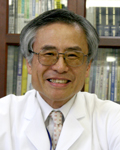The 18th General Meeting of the Japan Society of Hepatology President Hiroshi Fukui(Department of Gastroenterology, Endocrinology and Metabolism, Nara Medical University) |
 |
It gives me great pleasure to announce that the 18th Annual Meeting of the Japan Society of Hepatology will be held in Kobe City as a part of JDDW 2014, on Thursday 23rd and Friday 24th of October, 2014. I am honored and truly grateful to the members of the Japan Society of Hepatology and everyone involved for giving me this opportunity.
The central pillar of discussion at the upcoming meeting will be the idea that “Progress in hepatic pathology will bring a brighter future.” We chose this theme because research in hepatic pathology is not only crucial to the field of hepatology, but is also a key to a better future for both the patient and the specialist. While advanced diagnoses and treatments have helped many patients to be completely cured in recent years, doctors are still confronted by some cases that are difficult to counter due to their greatly advanced or complex clinical state. Despite a rapidly increasing number of patients who are cured of viral hepatic diseases, steatohepatitis—which is deeply connected with people’s everyday lifestyles—and hepatic cirrhosis and liver cancers caused by steatohepatitis are becoming bigger challenges. In addition, multi-organ complications associated with aging have become a big issue these days.
Comprising multiple medical societies, JDDW brings advantages not only in terms of linking member societies to facilitate the selection and discussion of topics from different perspectives and using various approaches; it also helps in the search for new possibilities by shedding light on interdisciplinary and specialized areas that require multidisciplinary treatment. Based on these objectives, the 2014 meeting will feature for the first time a session called the “integrated program,” which is organized by the member societies. For this first edition of the session, our society and the Japanese Society of Gastroenterological Surgery have proposed the topics of “Post-liver transplant issues” and “Selection of treatment for metastatic liver cancer.” I hope that this session will provide a great opportunity for productive discussions with members from other societies.
In order to make the sessions more internationally diverse, we have planned two English symposiums named “Mechanism of hepatic and pancreatic fibrosis: Clinical implications” and “Stem cells in liver regeneration and therapy: Present and future scope.” As we will be welcoming world-renowned pioneers in this field, Dr. Snorri S. Thorgeirsson and Dr. Scott L. Friedman as keynote speakers, I sincerely expect enthusiastic involvement in the presentations and active discussion from both domestic and international scientists.
The meeting includes a wide range of discussions. In the three theme sessions titled “Treatment strategies for Hepatitis B for prevention and control of liver cancer,” “New developments and destinations in Hepatitis C treatment,” and “Multidisciplinary treatment of advanced hepatocellular carcinoma: from the viewpoints of prognosis and QOL,” we will discuss clinically important problems that are receiving widespread attention. The two theme sessions titled “Changes in people’s lifestyles and hepatic pathology: toward future examination and treatment of hepatic disease” and “Clinical state analysis and new treatment of NAFLD/NASH” will examine the major future trends in hepatology. In terms of diagnosis, “Biomarker research for the future examination and treatment of liver cancer” and “Utilizing imaging diagnosis in the latest treatments for liver diseases” will be covered. The themes titled “New treatment strategies for hepatic cirrhosis complications,” “Hepatic pathology and advancements in the treatment from the perspective of hepato-enteric correlation” and “Acute liver failure: projection of new treatment for better prognosis” will be suitable for scientists who are keen to better understand the link between hepatic pathology and other organs. In addition, we will discuss “Autoimmune hepato-biliary diseases: clinical status analysis and further efforts for treatment” and “Optimal care for senile hepatic disease: further efforts for individualized treatment.” The purpose of setting these themes is to better understand the nature of pathology and to recognize the diversity of diseases so that personalized medicine can be pursued and provided.
Despite certain constraints facing the JDDW as a whole, we have tried our best to incorporate all of the most useful ideas and opinions into the session themes. All of the presentations, including those on general topics, will be delivered in digital formats from this event on. I encourage you to submit many topics that develop the future of hepatology and that can lead to the development of new areas, and to make the most of this opportunity to present your research to our eager audience using PowerPoint.
Finally, it only takes an hour to travel from Kobe to Nara. I hope that as well as participating in the meeting, many of you will take this opportunity to make a side trip to the ancient city of Nara. Thank you.


